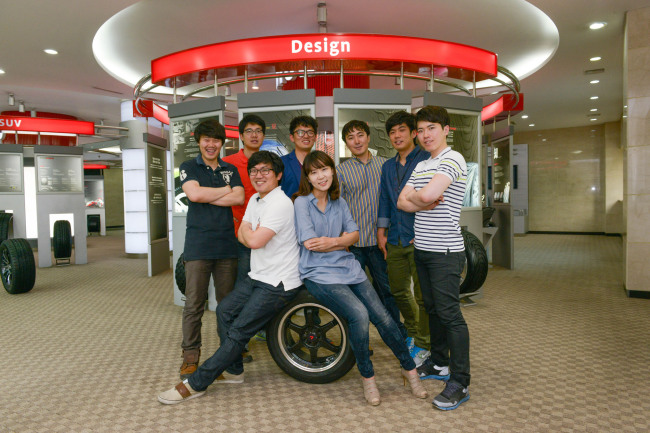GWANGJU ― The scene at Kumho Tire’s research and development center was of nine young designers working with an unusual canvas ― black, rubber tires.
Their office, filled with the scent of rubber, looked more like a repair shop than a design lab. But it was here that two Red Dot Award-winning tires were born.
“Small differences can make a tire unique, although most consumers would never notice,” said senior researcher Park Jae-pil. “Our mission is to create tires that can go faster and last longer. At the same time, we’re tasked to make tires look better.”
 |
Designers at Kumho Tire pose at the company’s research and development center in Gwangju. (Kumho Tire) |
Tires, despite being among the most essential components of a car, are largely overlooked because most people are more interested in the design of the actual vehicle.
But as Park and his fellow designers point out, tires can actually affect how safe the ride will be.
Up to 70 percent of tire function, they said, is dependent on the tread pattern, and is closely related to safety. The designers spend much of their time creating tread patterns on small strips of paper measuring about 200 millimeters in length and 40 millimeters in width, with 60 to 70 versions of the pattern completing the final tread design.
Until the final product comes out, designers draw several patterns and test them with engineers.
While their priority is on functionality, designers still strive to make tires more visually appealing to customers.
“Each tire has its own beauty even though only a small group of fanatics will appreciate it,” said Park In-hee, the sole female designer on the team, adding she had been unfamiliar with the field of tire design before joining the company.
“In tread design, a small groove or dimple can add a whole new different look to a tire. Sidewall design allows us to show our brand identity.”
A tiny dimple at the end of each groove led Kumho’s eco-friendly tire, the Ecowing ES01, to win the Red Dot Design award in March.
It was the first time that a Korean tire maker won the prestigious design award for two years running.
The dimple, inspired by dewdrops, aims to disperse heat. As a result, the tire maximizes energy efficiency by reducing rolling resistance and ensures optimal drive stability by increasing wet grip.
For the company’s first Red Dot winner last year, the Ecsta LE Sport, a high-performance sports tire, the design team decided to adopt “Koreanness.”
“We were seeking a sporty image for the high-performance tire and the sleek movement of a crane popped up,” said Park Chang-jung, who incorporated a crane’s wing into the sidewall design.
“A crane is a bird that represents Korea. That uniqueness may have appealed to the Red Dot panel ― most of them are Europeans.”
The premium tire was also given the iF Product Design Award last year.
Even though Kumho operates four R&D centers in Korea, China, the United States and Europe, the Korean team has been leading design work thus far.
Until the early 2000s, Kumho Tire had only three designers. The current nine designers is still a small number compared to other Korean tire makers that have dozens.
Despite their small number, the Kumho designers seem to have worked closely as attested to by their achievements in recent years.
Other than winning international design awards, Kumho now provides its tire products to global carmakers such as BMW, Mercedes-Benz, Volkswagen, Chrysler, GM and Ford. Last year, it was the first Korean tire manufacturer in the Mini John Cooper Works GranPrix, the special edition racing car of BMW’s premium small car brand.
In April, the company also announced it would provide the nation’s first electric car-only tires for Renault Samsung Motors’ new all-electric compact SM3 Z.E.
“Until recently, we have tried to reveal our brand identity through rather talkative design. From now, we will put more emphasis on streamlining our design philosophy,” said Park, the senior researcher.
According to him, many tire designers suffer from backache as they are always bending over vehicles to check out the tire tread.
“On most vehicles, a tire is actually the only visible component displaying a manufacturer’s brand name that is different from the carmaker. We feel pride in it.”
By Lee Ji-yoon (
jylee@heraldcorp.com)








![[Today’s K-pop] Blackpink’s Jennie, Lisa invited to Coachella as solo acts](http://res.heraldm.com/phpwas/restmb_idxmake.php?idx=644&simg=/content/image/2024/11/21/20241121050099_0.jpg)